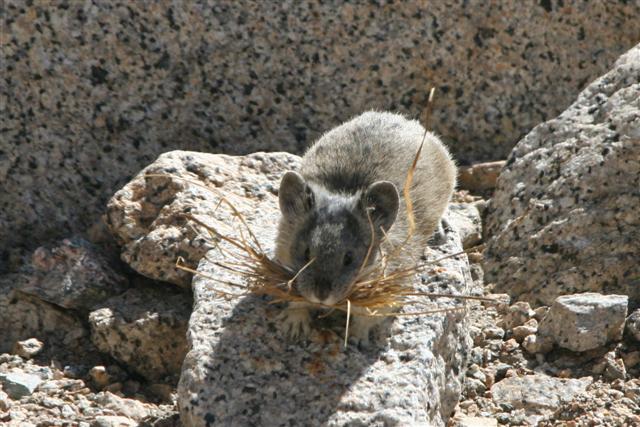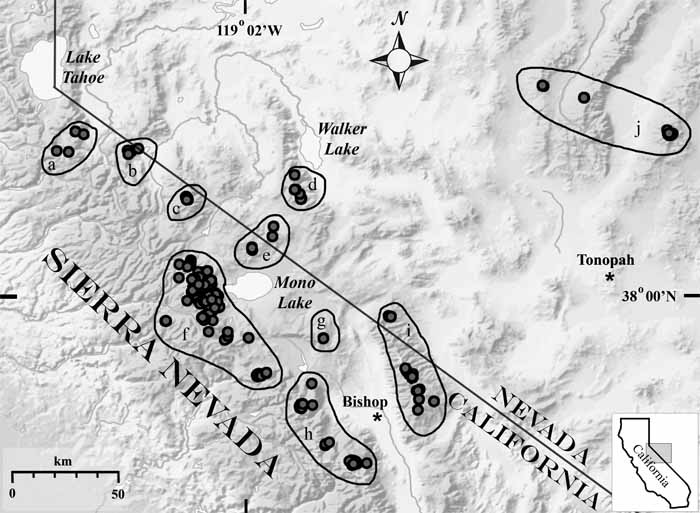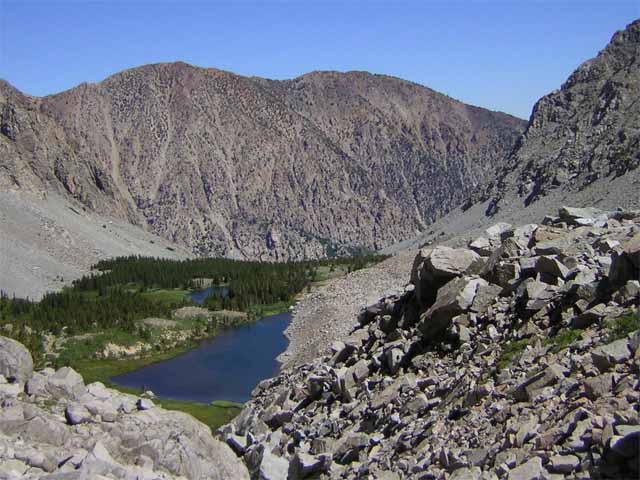Sierra Nature Notes, Volume 9, March 2010
American Pika are thriving in the Sierra Nevada and southwestern
Great Basin
Rock formations buffer pika from warming temperatures
Summary of Distribution and Climatic Relationships
of the American Pika (Ochotona princeps) in the Sierra Nevada
and Western Great Basin, U.S.A.; Periglacial Landforms as Refugia in Warming
Climates
Constance Millar and Robert Westfall
USDA Forest Service, Pacific Southwest Research Station
Sierra Nevada Research Center
800 Buchanan St. Western Annex Bldg.
Albany, CA 94710 USA

Vulnerability
of pika habitat to global warming has been an escalating concern, causing
speculation that the range of suitable pika habitat will contract upward
in elevation as lower elevation site temperatures increase. (See previous
Sierra Nature Notes article: Persistence
of pikas in two low-elevation national monuments in the western United
States by Erik A. Beever, Ph.D.). However, new research
addressing climate change questions documents that American pika
in the Sierra Nevada and southwestern Great Basin are thriving and persist
in a wider range of temperatures than previously discovered. Results were
recently published in a paper titled “Distribution and Climatic Relationships
of the American Pika (Ochotona princeps) in the Sierra Nevada
and Western Great Basin, U.S.A.; Periglacial Landforms as Refugia in Warming
Climates,” by Constance Millar and Robert Westfall in the February
2010 issue of the journal “Arctic, Antarctic and Alpine Research.”
A small mammalian relative of rabbits and hares, the American pika inhabits
rocky slopes of western North American mountains. Pikas tolerate cold climate
environments through a combination of physiological
and behavioral
adaptations that includes dense pelage, high basal metabolism, high core body
temperature,
discriminate forage choice, food stock-piling, and habitat selections. However,
these same adaptations may make them sensitive to even mildly warm climates.
The historic elevations for these subspecies range from 2140m to over 3900m
(7,000 to 12,800 feet), with most records
from the central Sierra Nevada and Great Basin above ~2500m (8,000 feet). Pikas
can also be recognized by their distinctive
call (YouTube video).
Their favored habitat is in talus and fractured boulder slopes of glacial origin called rock-ice features (RIF) and where the boulder fields are situated adjacent to vegetation suitable for forage.
 |
| Figure 1: Pika Study Area. East slope of California's Sierra Nevada mountains and interior ranges of Nevada's Great Basin. |
Millar and Westfall developed and used a rapid assessment method to detect recent presence of American pika in 94 percent of 420 sites in the Sierra Nevada (Figure 1), California, southwestern Great Basin, central Great Basin and central Oregon Cascades ranges. Occurrence and non-detection sites were then compared to pika’s habitat affinities to rock formation types and the climatic features of those sites. Rock-ice feature landforms (Figure 2) are important habitat components providing insulation and refugia from outside air temperature increases and accounted for 83 percent of the sites. Site climate data indicate that in this study region, pika tolerate a wider range of temperatures and precipitation than previously interpreted. This may be due to temperature buffering as a result of the microclimate created within the rock-ice features. Millar and Westfall placed 13 temperature dataloggers at several pika sites. The instruments were set for 4-hr intervals, inserted within white PVC tubes to avoid direct solar radiation, and placed either in ambient air in a rock-sheltered location at the RIF surfaces, or within RIF rock matrices ~1m (3 feet) below the surface of the RIF.
The topographic contexts of rock-glacier and boulder-stream landforms are such that climatic conditions tend to be cooler than means expected for their elevations. This results not only from northerly aspects of these RIFs but also from local topographic contexts that favor cold micro-sites and foster RIF development. These include steep rocky slopes; narrow and deep canyons; cirque head locations; slopes below cliffs, rock chutes, and avalanche tracks; and contexts where solar insolation is reduced and cold-air drainage, cold-air pooling, and inversions are common. These conditions result in cooler summer temperatures favored by pikas, and could contribute to local depression of pikas’ elevation limit.
RIFs generate unique microclimatic conditions within the rock landform in both summer and winter that depart from expected surface air temperatures for their elevation, topographic context, or season. During the warm season, within-rock matrix air temperatures are significantly lower than adjacent bedrock or soil, a condition known as negative thermal anomaly. These anomalies have been recorded as large as 4°-7°C (40° - 45°F) within boulder-stream talus relative to adjacent mineral soil and up to 2°C (36°F) colder than adjacent morainal till and bedrock. Cold air is often felt as a persistent breeze as it circulates out the base of RIF landforms. During the cold season, an opposite thermal anomaly can develop within open RIF blockfields such that within-rock matrix winter temperatures are warmer than ambient surface air. This occurs more commonly in the upper elevations within the rocky matrix of the landforms, in that internally heated air is ventilated upslope within the talus and exhaled through snow windows or snow funnels created by the warm air. Temperatures of ventilated air have been recorded in the Japan Alps at the top of RIF blocky fields that are as much as 11.7°C (a relative difference of about 21ºF) warmer than air near the base of the landform over an elevational difference of only 100m (328 feet).
This pattern
of RIF within-rock matrix environments being cooler than expected for elevation
mean summer temperatures, and warmer than expected for winter temperatures
creates highly
favorable thermal conditions for pikas.
 |
Figure
2: Boulders,
talus and vegetation in foreground are typical pika habitat, though
not the distant moraine to the right of the lake. |
Low elevation populations are usually in relatively warmer locations, so
have been thought to be at risk due to rising 20th-21st century temperatures.
Millar & Westfall found, however, that 12% of their occupied sites were
lower in elevation than the historic (early 20th century) records indicate,
revealing that pika live 500 meters (1640 feet) below what was previously
known for this region. The
elevational range of CA and NV sites was very broad,
covering 2060m (6,800 feet) elevation, and extending from a low of 1827m to
a high of 3887m (5,994 to 12,752 feet). They did not
find an association of elevation with age of sites; old sites occurred at low
to high elevations.
This number, diversity of sites, occupancy, and elevational range suggest greater
distribution in
the Sierra Nevada and Great Basin than has been found in other studies in our
region. The large number of sites also
yielded a wider climate envelope than has been described for our region, suggesting
a wide
thermal tolerance for pikas there.
Results of this study suggest that pikas in the Sierra Nevada and southwestern Great Basin appear to be thriving and tolerating a wide range of thermal environments. This study also suggests a greater distribution in the Sierra Nevada and Great Basin than has been found in other studies in these regions, and provides important baseline surveys that can be used in future pika ecology and population studies.
***
This article was adapted from the U.S. Forest Service Pacific Southwest Research Station announcement of the research and excerpts from Distribution and Climatic Relationships of the American Pika (Ochotona princeps) in the Sierra Nevada and Western Great Basin, U.S.A.; Periglacial Landforms as Refugia in Warming Climates, in the February 2010 issue of the journal “Arctic, Antarctic and Alpine Research” by Constance Millar and Robert Westfall.
Further Reading
Distribution and Climatic Relationships of the American Pika (Ochotona princeps) in the Sierra Nevada and Western Great Basin, U.S.A.; Periglacial Landforms as Refugia in Warming Climates, by Constance Millar and Robert Westfall.
Persistence of pikas in two low-elevation national monuments in the western United States by Erik A. Beever, Ph.D. in Sierra Nature Notes.
Our Founder Questions? Go to About Our New Site |
Masthead
Photo from: |